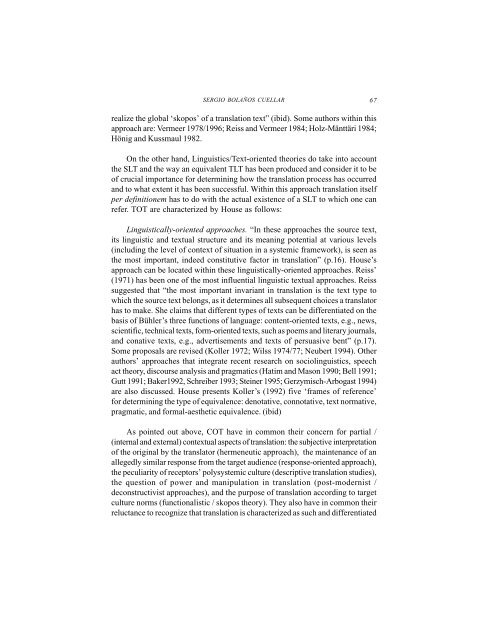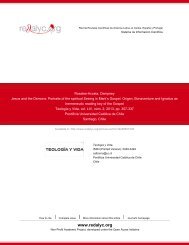A Key Concept in Modern Translation Theory - Redalyc
A Key Concept in Modern Translation Theory - Redalyc
A Key Concept in Modern Translation Theory - Redalyc
You also want an ePaper? Increase the reach of your titles
YUMPU automatically turns print PDFs into web optimized ePapers that Google loves.
SERGIO BOLAÑOS CUELLAR<br />
67<br />
realize the global ‘skopos’ of a translation text” (ibid). Some authors with<strong>in</strong> this<br />
approach are: Vermeer 1978/1996; Reiss and Vermeer 1984; Holz-Mänttäri 1984;<br />
Hönig and Kussmaul 1982.<br />
On the other hand, L<strong>in</strong>guistics/Text-oriented theories do take <strong>in</strong>to account<br />
the SLT and the way an equivalent TLT has been produced and consider it to be<br />
of crucial importance for determ<strong>in</strong><strong>in</strong>g how the translation process has occurred<br />
and to what extent it has been successful. With<strong>in</strong> this approach translation itself<br />
per def<strong>in</strong>itionem has to do with the actual existence of a SLT to which one can<br />
refer. TOT are characterized by House as follows:<br />
L<strong>in</strong>guistically-oriented approaches. “In these approaches the source text,<br />
its l<strong>in</strong>guistic and textual structure and its mean<strong>in</strong>g potential at various levels<br />
(<strong>in</strong>clud<strong>in</strong>g the level of context of situation <strong>in</strong> a systemic framework), is seen as<br />
the most important, <strong>in</strong>deed constitutive factor <strong>in</strong> translation” (p.16). House’s<br />
approach can be located with<strong>in</strong> these l<strong>in</strong>guistically-oriented approaches. Reiss’<br />
(1971) has been one of the most <strong>in</strong>fluential l<strong>in</strong>guistic textual approaches. Reiss<br />
suggested that “the most important <strong>in</strong>variant <strong>in</strong> translation is the text type to<br />
which the source text belongs, as it determ<strong>in</strong>es all subsequent choices a translator<br />
has to make. She claims that different types of texts can be differentiated on the<br />
basis of Bühler’s three functions of language: content-oriented texts, e.g., news,<br />
scientific, technical texts, form-oriented texts, such as poems and literary journals,<br />
and conative texts, e.g., advertisements and texts of persuasive bent” (p.17).<br />
Some proposals are revised (Koller 1972; Wilss 1974/77; Neubert 1994). Other<br />
authors’ approaches that <strong>in</strong>tegrate recent research on sociol<strong>in</strong>guistics, speech<br />
act theory, discourse analysis and pragmatics (Hatim and Mason 1990; Bell 1991;<br />
Gutt 1991; Baker1992, Schreiber 1993; Ste<strong>in</strong>er 1995; Gerzymisch-Arbogast 1994)<br />
are also discussed. House presents Koller’s (1992) five ‘frames of reference’<br />
for determ<strong>in</strong><strong>in</strong>g the type of equivalence: denotative, connotative, text normative,<br />
pragmatic, and formal-aesthetic equivalence. (ibid)<br />
As po<strong>in</strong>ted out above, COT have <strong>in</strong> common their concern for partial /<br />
(<strong>in</strong>ternal and external) contextual aspects of translation: the subjective <strong>in</strong>terpretation<br />
of the orig<strong>in</strong>al by the translator (hermeneutic approach), the ma<strong>in</strong>tenance of an<br />
allegedly similar response from the target audience (response-oriented approach),<br />
the peculiarity of receptors’ polysystemic culture (descriptive translation studies),<br />
the question of power and manipulation <strong>in</strong> translation (post-modernist /<br />
deconstructivist approaches), and the purpose of translation accord<strong>in</strong>g to target<br />
culture norms (functionalistic / skopos theory). They also have <strong>in</strong> common their<br />
reluctance to recognize that translation is characterized as such and differentiated
















